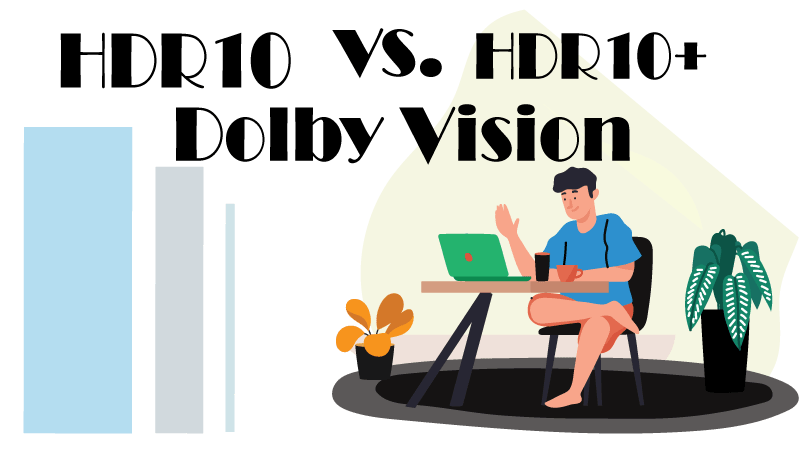
Tried purchasing a projector lately? You must have met with a myriad of vendors’ suggestions on getting one with either HDR10, HDR10+, or Dolby Vision (HDR10+ vs HDR10+ vs Dolby vision).
This probably left you wondering:
what each one entails,
what makes them different,
and which is better for your projector. (Check three best projectors of 2024)
In this article,
I would be answering your questions and telling you all you need to know (or rather quite enough) to help you make your choice between the three HDR formats.
What Is HDR?
Before I move any further, it is germane that I define what HDR means. The Acronym HDR stands for High Dynamic Range. Keep that in mind because I would be calling it HDR from here on. Well, knowing the full meaning of the acronym doesn’t really define it.
So what is HDR?
To fully answer that question, I would have to take a detour into photography.
In photography, HDR refers to a technique used to generate more detail in a picture without increasing resolution.
The reason why you need HDR in the first place is that, during a regular photography session, you have to capture both dark areas and light areas.
Most times, these pictures are either overexposed or underexposed.
To solve this problem, HDR was introduced to improve the amount of detail in an image by balancing out the light and dark areas. When this is done, the picture looks more balanced and detailed.
In the end, what you have is an image that is more vivid, pleasing, and surreal.
To fully understand how HDR works, I must define the four fundamental concepts that do HDR work.
1. Luminance
Luminance is a shiny term that refers to how much light a thing can emit—think of how much light a screen can emit or how bright your projector was when you displayed that cool picture. Now that is Luminance.
2. Dynamic Range
When you think about Dynamic range, just think about contrast. This refers to the difference between the brightest and darkest parts of an image. So, in essence, it’s basically the darkest your picture can be and the brightest it can be.
3. Color space
This refers to the maximum saturation for the primary colors red, blue, and green in an image.
4. Bit depth
This is the amount of data used in describing the brightness in color.
So That’s what makes the HDR work. Now take all of these and make it talk all about color.
In HDR for video, which we are more concerned about, all of these come together to give off a more appealing and realistic color.
It improves the vividness and liveliness of color and also lets us see more color. So at the end of the day, what you have is a video where the blacks are well exposed, and the image pops. This is by far the best that video can offer right now.
HDR10 vs. Dolby Vision vs. HDR10+: The HDR Formats
So, there are different HDR formats out there. In this article, I would be focusing on just three: the HDR10, HDR10+, and Dolby Vision.
HDR10
HDR10 is an open standard format of the HDR video, and so is more common. HDR10 supports up to 1000 nits of peak brightness. It also supports up to 10-bit color depth, which provides 1024 shades of color. This can yield over a billion colors. This brings a whole new range of possibilities into the picture.
With HDR10, you can see more real and vivid videos in its representation of details and color. The way HDR10 works is by sending static Meta-data to the video stream. When this is done, one setting is picked to adjust the coloration all through the movie. What you get is better video quality, showing more color detail.
HDR10+
HDR10+ is Samsung’s improvement on the HDR10. It supports up to 4000 nits. It also supports up to 12-bit color depth, which provides 4096 shades of color. This can yield over 68 billion colors.
Now that trumps the efforts of the HDR10.
It works by sending dynamic Meta-data to the video stream. This is the game-changer for HDR10+. With a dynamic Meta-data, the video’s coloration changes from frame to frame, giving a more vivid representation of the color. This produces a more vivid quality as compared with the HDR10.
Dolby Vision
The Dolby Vision is Dolby’s HDR format. Originally created to compete with the HDR, it is built to belong to Dolby. What that means is that you have to purchase the rights to make use of this format.
It is basically the same as the HDR10 ( or better still, the HDR10 is just like it since it was made after the Dolby Vision). This makes it the first format ever to use dynamic Meta-data. It supports up to 12bitcolour depth, which produces 4096 shades of color and, consequently, 68 billion colors.
Which Is Better?
Without controversy, the HDR10 doesn’t major up to the other two formats. While some may want to classify the HDR10 and the HDR10+ as one, there is a clear difference between them, and the HDR10+ is more alike to the Dolby Vision. Below is a table showing the basic features of the three formats:
| HDR10 | HDR10+ | Dolby Vision | |
| Licensing | No | No | Yes |
| Color depth | 10 bit | 12 bit | 12 bit |
| Meta-data | Static | Dynamic | Dynamic |
| Colour possibility | 1 billion | 68 billion | 68 billion |
| Gear and content | More available | Less available | Less available |
| control | More control | More control | Less control |
The question still remains, which is better for the projector.
The answer to that question could be very dicey, but We would attempt it. When it comes to the format’s potential, then HDR10 is out of the game, and the reasons are apparent.
HDR10+ and Dolby Vision offer quality that trumps every effort of the HDR10. They offer a better picture quality as they can display more colors and give more colorful, more detailed, and more vivid images. They both have a color depth of 12 bit, can both display 68 billion colors as opposed to the 10 bit and 1 billion colors that the HDR10 can display.
With this display possibility, there is less banding and a more seamless color transition, which looks more like what is obtainable with the human eyes. This would definitely look beautiful when cast on a projector.
On the ground of content, the HDR10 would win.
This is based on two reasons.
First is the fact that the Dolby Vision has a licensing. This means you have to pay Dolby to make use of its format.
The HDR10 and the HDR10+ are free to use, although some annual fees must be paid to the formats’ owner, especially the HDR10+. This makes the HDR10 and the HDR10+ a more accessible format.
What about 2024?
While the HDR10 and the 10+ are readily accessible, the HDR10 and Dolby are not particularly ready for the show at the moment. Most producers and companies are at home with the HDR at the moment and use it more since it is readily available and accessible. Until that changes, the HDR10 wins the content battle as there is a wide availability of HDR content in that format.
Another pointer is the limit of today’s technology. While HDR10+ and Dolby Vision can produce more dynamic and vivid images, there is little or no technology to handle all of that beauty. There are few TVs and projectors that can attempt handling the 68 billion gradients of HDR10+ and Dolby Vision.
What about the future?
Maybe in the future, there will be more projectors that can handle its beautiful array of colors. But the HDR10, on the other hand, has an ample amount of technology and gear to support it. When you are watching, you see all of the possibilities. The difference between the Dolby Vision and the HDR10 might be noticeable, but we can’t utilize that difference as much as we would want to yet.
Verdict
The verdict is in. Drum roll, please!!!
At the moment, HDR10+ and Dolby Vision might be the giants when it comes to possibilities. They can give you a more vivid image with greater detail and luminosity. While we are at it, we must not forget to mention the 68 Billion colors that it can portray.
However, if we want to talk about plausibilities, the HDR10 is king. When you consider that anybody can access it and use it and that it is the format with a lot of content, you can’t but veto the HDR10. Maybe sometime in the future, the HDR10+ and the Dolby Vision would meet up with the HDR10 regarding content and acceptability.
Until then, HDR10 is an excellent option for your projector. The HDR10+ and Dolby Vision would definitely look better. But until they are ready (in the sense that the HDR10 is), I think it’s just fine we stick with the HDR10.

